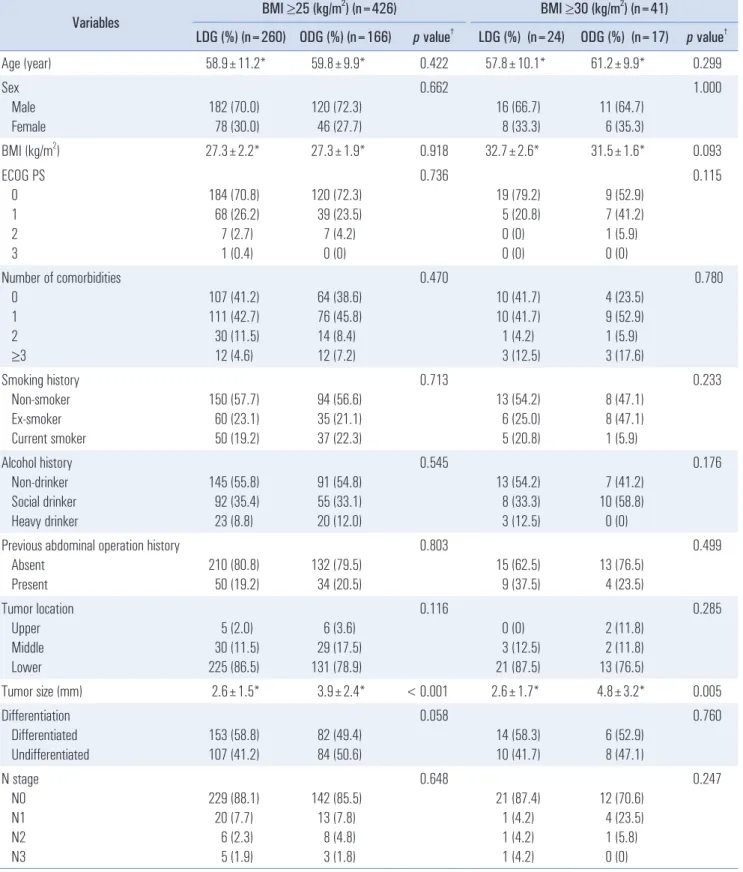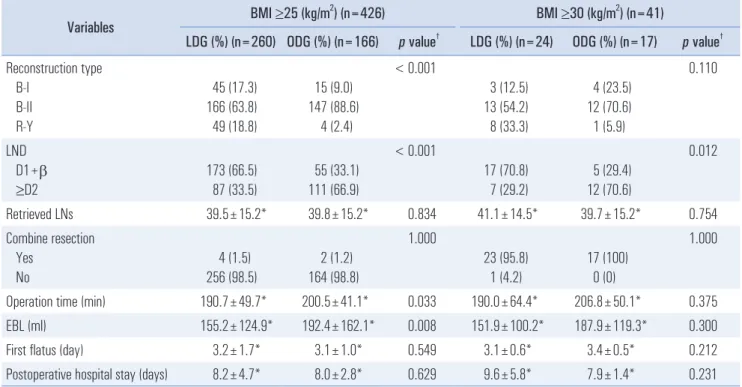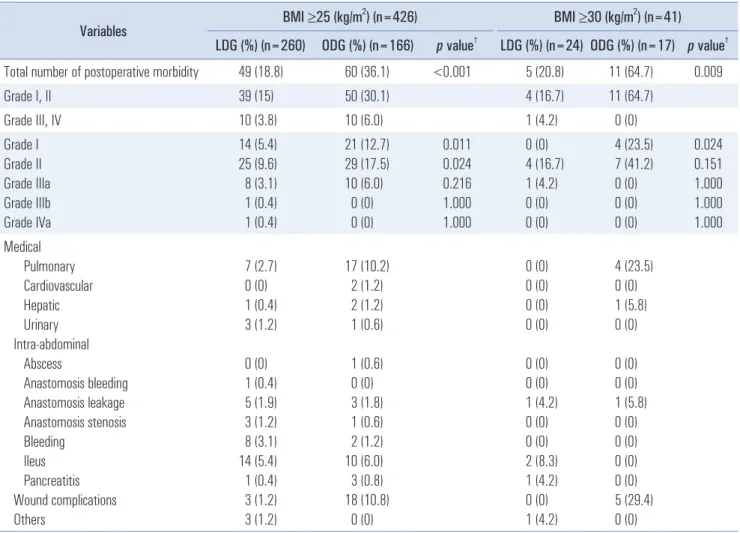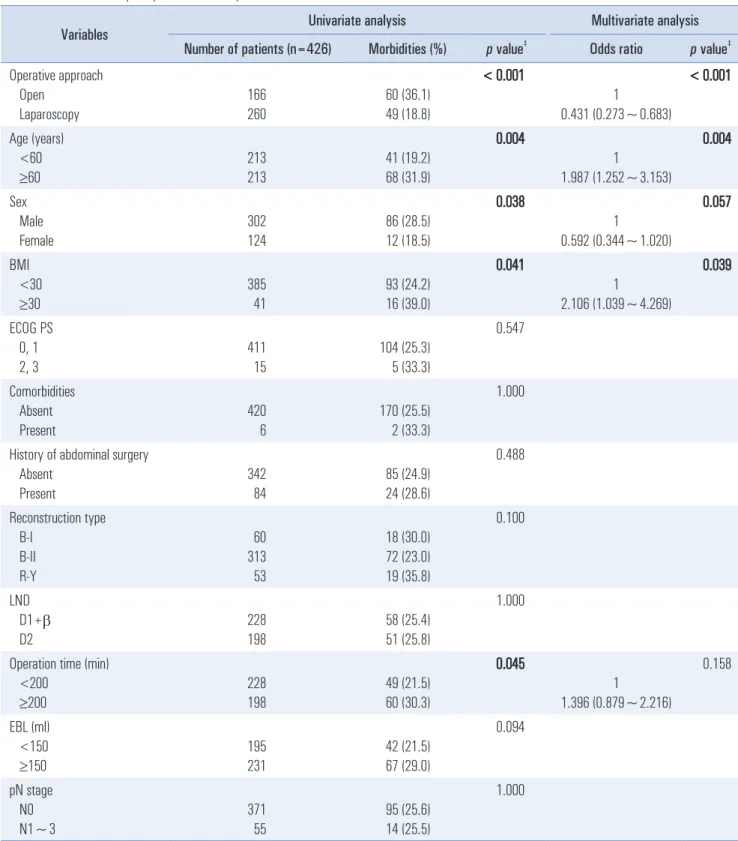Comparison Surgical Outcomes between Laparoscopic and Conventional Distal Gastrectomy for Early Gastric Cancer in Obese Patients
Young Sun Choi, M.D., Dong Jin Kim, M.D., Han Mo Yoo, M.D., Kyo Young Song, M.D., Cho Hyun Park, M.D.
Department of Surgery, College of Medicine, The Catholic University of Korea, Seoul, Korea
Purpose:
In this study, we explored the safety of laparoscopic gastrectomy in obese gastric cancer patients compared with conventional open gastrectomy based on early surgical outcomes.Methods:
A total of 462 patients who underwent curative gastrectomy for early gastric adeno- carcinoma from January 2000 to December 2014 were enrolled. Two obesity cohorts were defined according to a body mass index (BMI) of ≥25 kg/m2 versus ≥30 kg/m2. Those cohorts were further divided into the laparoscopic distal gastrectomy (LDG) and open distal gastrectomy (ODG) groups, and clinicopathologic characteristics were compared with early surgical results.Results:
There were no significant differences in clinicopathologic characteristics between the LDG and ODG groups in the BMI ≥25 or BMI ≥30 cohorts. For the overall complication rate, fewer complications were observed in the LDG than ODG group in both cohorts. Among the overall complications, significant differences were observed in the minor complication rates (Clavien-Dindo I or II), but no significant difference was observed in the rate of Clavien-Dindo III or higher complications. For risk factor analysis of postoperative complications, open distal gastrectomy, age>60 years, and BMI ≥30 were independent risk factors for postoperative morbidity among all obese patients.
Conclusion:
LDG may be a better procedure to improve surgical outcomes in patients with obesity undergoing surgery for early gastric cancer in terms of less excessive blood loss, shorter operation time, and lower complication rates.Keywords:
Stomach neoplasm, Laparoscopy, Complication, ObesityReceived June 27, 2017 Revised 1st August 1, 2017
2nd August 5, 2017 Accepted August 8, 2017
Corresponding author Han Mo Yoo
Department of Surgery, Daejeon St. Mary’s Hospital, College of Medicine, The Catholic University of Korea, 64, Daeheung-ro, Jung-gu, Daejeon 34943, Korea
Tel: +82-42-220-9520 Fax: +82-2-6442-4975
E-mail: kalpolipse@catholic.ac.kr
This is an Open Access article distributed under the terms of the Creative Commons Attribution Non-Commercial License (http://
creativecommons.org/licenses/by-nc/4.0/) which permits unrestricted non-commercial use, distribution, and reproduction in any medium, provided the original work is properly cited.
Copyright © 2017 The Journal of Minimally Invasive Surgery. All rights reserved.
Journal of Minimally Invasive Surgery
J Minim Invasive Surg 2017;20(3):101-107
InTRODUCTIOn
Obesity is rapidly increasing on a global scale and is defined as excess fat accumulation, which can lead to health problems.
The criteria for obesity is a body mass index (BMI) ≥30 kg/
m
2in Western countries and ≥25 kg/m
2in Asian countries.
1Globally, 39% and 13% of adults aged ≥18 years were over- weight and obese, respectively, in 2014. According to the Ko-
rea National Health and Nutrition Examination Survey, the obesity rate in south Korea is increasing, from 25.8% in 1998 to 32.8% in 2012.
2As obesity in the population increases, the proportion of obese patients with gastric cancer is also in- creasing.
Generally, gastric cancer surgeries in obese patients are technically demanding, showing limited oncologic safety.
Large amounts of intra-abdominal fat can obscure vascular
Table 1. Clinicopathologic characteristics of the patients
Variables BMI ≥25 (kg/m
2) (n=426) BMI ≥30 (kg/m
2) (n=41)
LDG (%) (n=260) ODG (%) (n=166) p value
†LDG (%) (n=24) ODG (%) (n=17) p value
†Age (year) 58.9±11.2* 59.8±9.9* 0.422 57.8±10.1* 61.2±9.9* 0.299
Sex Male Female
182 (70.0) 78 (30.0)
120 (72.3)
46 (27.7)
0.662
16 (66.7) 8 (33.3)
11 (64.7)
6 (35.3)
1.000
BMI (kg/m
2) 27.3±2.2* 27.3±1.9* 0.918 32.7±2.6* 31.5±1.6* 0.093
ECOG PS 0 1 2 3
184 (70.8) 68 (26.2) 7 (2.7) 1 (0.4)
120 (72.3)
39 (23.5) 7 (4.2) 0 (0)
0.736
19 (79.2) 5 (20.8) 0 (0) 0 (0)
9 (52.9) 7 (41.2) 1 (5.9) 0 (0)
0.115
Number of comorbidities 0
1 2 ≥3
107 (41.2) 111 (42.7) 30 (11.5) 12 (4.6)
64 (38.6) 76 (45.8) 14 (8.4) 12 (7.2)
0.470
10 (41.7) 10 (41.7) 1 (4.2) 3 (12.5)
4 (23.5)
9 (52.9) 1 (5.9) 3 (17.6)
0.780
Smoking history Non-smoker Ex-smoker Current smoker
150 (57.7) 60 (23.1) 50 (19.2)
94 (56.6) 35 (21.1) 37 (22.3)
0.713
13 (54.2) 6 (25.0) 5 (20.8)
8 (47.1) 8 (47.1) 1 (5.9)
0.233
Alcohol history Non-drinker Social drinker Heavy drinker
145 (55.8) 92 (35.4) 23 (8.8)
91 (54.8) 55 (33.1) 20 (12.0)
0.545
13 (54.2) 8 (33.3) 3 (12.5)
7 (41.2) 10 (58.8)
0 (0)
0.176
Previous abdominal operation history Absent
Present
210 (80.8) 50 (19.2)
132 (79.5) 34 (20.5)
0.803
15 (62.5) 9 (37.5)
13 (76.5) 4 (23.5)
0.499
Tumor location Upper Middle Lower
5 (2.0) 30 (11.5) 225 (86.5)
6 (3.6) 29 (17.5) 131 (78.9)
0.116
0 (0) 3 (12.5) 21 (87.5)
2 (11.8) 2 (11.8) 13 (76.5)
0.285
Tumor size (mm) 2.6±1.5* 3.9±2.4* < 0.001 2.6±1.7* 4.8±3.2* 0.005
Differentiation Differentiated Undifferentiated
153 (58.8) 107 (41.2)
82 (49.4) 84 (50.6)
0.058
14 (58.3) 10 (41.7)
6 (52.9) 8 (47.1)
0.760
N stage N0 N1 N2 N3
229 (88.1)
20 (7.7) 6 (2.3) 5 (1.9)
142 (85.5)
13 (7.8) 8 (4.8) 3 (1.8)
0.648
21 (87.4) 1 (4.2) 1 (4.2) 1 (4.2)
12 (70.6)
4 (23.5) 1 (5.8) 0 (0)
0.247
BMI = Body Mass Index; ECOG = Eastern Cooperative Oncology Group. *Standard deviation.
†Indicates c
2test.
structures and normal surgical planes during surgery. Preop- erative BMI is a risk factor for postoperative complications.
3Moreover, complete lymph node dissection is challenging during surgery in obese patients. These issues are equally challenging during laparoscopic surgery. In the past, laparo- scopic surgery was not attempted in obese patients due to the above-mentioned problems. However, technical advancements have overcome these limitations. At this time, laparoscopic gastrectomy has advantages over open gastrectomy regarding postoperative outcomes and quality of life.
4-6In the recently published KLASS-01 trial morbidity and mortality report, laparoscopic gastrectomy showed advantages in terms of es- timated blood loss, length of hospital stay, and overall com- plication rate, especially for wound complication.
7However, laparoscopic gastrectomy requires a longer operation time than that of open gastrectomy. Recently, the discrepancy in operation time has decreased due to technical improvements.
8However, the advantages of laparoscopic gastrectomy in obese patients remain controversial. In this study, we explored the safety of laparoscopic gastrectomy in terms of early surgical outcomes in obese gastric cancer patients.
MATERIALS AnD METHODS
From January 2000 to December 2014, 4,272 patients with gastric adenocarcinoma underwent gastrectomy at the Depart-
ment of Surgery, Seoul, St. Mary ’s Hospital. Eligible criteria were curative resection, distal gastrectomy, pathologically confirmed early gastric cancer, and range of lymph node dis- section D1+ or greater. Patients who underwent palliative or non-curative resection or combined resection were excluded.
The data were collected retrospectively from a prospectively collected database. Obesity and morbid obesity were defined as BMI ≥25 and BMI ≥30, respectively, according to Asian- Pacific guidelines. Among the 4,274 patients, two cohorts were defined: patients with BMI ≥25 and those with BMI ≥30. A total of 462 patients were included in the former cohort and 41 patients in the latter cohort. Those cohorts were further di- vided into the laparoscopic distal gastrectomy (LDG) and open distal gastrectomy (ODG) groups. Clinicopathologic char- acteristics and surgical results included the range of lymph node dissection, early surgical results including postoperative complications, and length of hospital stay. Comparisons of continuous variables were performed using Student’s t-test and categorical variables were assessed using Pearson ’s c
2test or a linear-by-linear association c
2test. Postoperative complica- tions were graded based on the Clavien-Dindo classification.
9In addition, univariate and multivariate analyses were per- formed to identify risk factors for the development of postop- erative complications. This study followed the 7th UICC TNM staging system (according to the American Joint Committee on Cancer [AJCC] 7th edition).
10Table 2. Postoperative and surgical outcomes
Variables BMI ≥25 (kg/m
2) (n=426) BMI ≥30 (kg/m
2) (n=41)
LDG (%) (n=260) ODG (%) (n=166) p value
†LDG (%) (n=24) ODG (%) (n=17) p value
†Reconstruction type
B-I B-II R-Y
45 (17.3) 166 (63.8) 49 (18.8)
15 (9.0) 147 (88.6)
4 (2.4)
< 0.001
3 (12.5) 13 (54.2) 8 (33.3)
4 (23.5) 12 (70.6) 1 (5.9)
0.110
LND D1+b ≥D2
173 (66.5) 87 (33.5)
55 (33.1) 111 (66.9)
< 0.001
17 (70.8) 7 (29.2)
5 (29.4) 12 (70.6)
0.012
Retrieved LNs 39.5±15.2* 39.8±15.2* 0.834 41.1±14.5* 39.7±15.2* 0.754
Combine resection Yes
No
4 (1.5) 256 (98.5)
2 (1.2) 164 (98.8)
1.000
23 (95.8) 1 (4.2)
17 (100) 0 (0)
1.000
Operation time (min) 190.7±49.7* 200.5±41.1* 0.033 190.0±64.4* 206.8±50.1* 0.375
EBL (ml) 155.2±124.9* 192.4±162.1* 0.008 151.9±100.2* 187.9±119.3* 0.300
First flatus (day) 3.2±1.7* 3.1±1.0* 0.549 3.1±0.6* 3.4±0.5* 0.212
Postoperative hospital stay (days) 8.2±4.7* 8.0±2.8* 0.629 9.6±5.8* 7.9±1.4* 0.231
LND = Lymph Node Dissection; EBL = Excessive Blood Loss. *Standard deviation.
†Indicates c
2test.
RESULTS
Clinicopathological characteristics
In the BMI ≥25 cohort, no significant differences in patient characteristics including age, sex, ECOG, number of comor- bidities, social history, or previous operation history were observed between the LDG and ODG groups. Tumor location, degree of differentiation, and N stage also showed no sig- nificant differences between the two groups. In the BMI ≥30 cohort, similar results were observed between the two groups (excluding mean tumor size). Tumor size in the LDG group was 2.6±1.5 cm, which was smaller than that (3.9±2.4 cm) in the ODG group (Table 1).
Postoperative and surgical results
In terms of surgical outcomes, there were differences in the type of reconstruction and extent of lymph node dissection
between the groups in the BMI ≥25 cohort and in the extent of lymph node dissection in the BMI ≥30 cohort. Billroth-II anastomosis was performed more commonly in the LDG than in the ODG group. In addition, more D2 lymph node dissec- tions were performed in the ODG than in the LDG (Table 2).
In the LDG group, 87 patients (33.5%) underwent >D2 lymph node dissection, and 173 patients (66.5%) underwent D1+
lymph node dissection. In the ODG group, 111 patients (66.9%) underwent >D2 lymph node dissection and 55 patients (33.1%) D1+ lymph node dissection. Nevertheless, the number of re- trieved lymph nodes showed no significant difference between the two groups (LDG vs. ODG: 39.5±15.2 vs. 39.8±15.2). An extended operation time was required in the ODG group com- pared with the LDG group in the BMI ≥25 cohort. However, the difference was minimal, and there was no significant dif- ference in the BMI ≥30 cohort. Less blood loss was observed in the LDG group (155.2±124.9 ml) than in the ODG group (192.4±162.1 ml) in the BMI ≥25 cohort. The postoperative clinical course showed no significant differences between the
Table 3. Postoperative morbidities within 30 postoperative days
Variables BMI ≥25 (kg/m
2) (n=426) BMI ≥30 (kg/m
2) (n=41)
LDG (%) (n=260) ODG (%) (n=166) p value
†LDG (%) (n=24) ODG (%) (n=17) p value
†Total number of postoperative morbidity 49 (18.8) 60 (36.1) <0.001 5 (20.8) 11 (64.7) 0.009
Grade I, II 39 (15) 50 (30.1) 4 (16.7) 11 (64.7)
Grade III, IV 10 (3.8) 10 (6.0) 1 (4.2) 0 (0)
Grade I Grade II Grade IIIa Grade IIIb Grade IVa
14 (5.4) 25 (9.6) 8 (3.1) 1 (0.4) 1 (0.4)
21 (12.7) 29 (17.5) 10 (6.0)
0 (0) 0 (0)
0.011 0.024 0.216 1.000 1.000
0 (0) 4 (16.7) 1 (4.2) 0 (0) 0 (0)
4 (23.5) 7 (41.2) 0 (0) 0 (0) 0 (0)
0.024 0.151 1.000 1.000 1.000 Medical
Pulmonary Cardiovascular Hepatic Urinary Intra-abdominal Abscess
Anastomosis bleeding Anastomosis leakage Anastomosis stenosis Bleeding
Ileus Pancreatitis Wound complications Others
7 (2.7) 0 (0) 1 (0.4) 3 (1.2) 0 (0) 1 (0.4) 5 (1.9) 3 (1.2) 8 (3.1) 14 (5.4) 1 (0.4) 3 (1.2) 3 (1.2)
17 (10.2) 2 (1.2) 2 (1.2) 1 (0.6) 1 (0.6) 0 (0) 3 (1.8) 1 (0.6) 2 (1.2) 10 (6.0) 3 (0.8) 18 (10.8)
0 (0)
0 (0) 0 (0) 0 (0) 0 (0) 0 (0) 0 (0) 1 (4.2) 0 (0) 0 (0) 2 (8.3) 1 (4.2) 0 (0) 1 (4.2)
4 (23.5) 0 (0) 1 (5.8) 0 (0) 0 (0) 0 (0) 1 (5.8) 0 (0) 0 (0) 0 (0) 0 (0) 5 (29.4) 0 (0)
†
Indicates c
2test.
two groups in terms of flatus day or length of hospital stay. Postoperative complications
There were more overall complications in the ODG than in the LDG group in both cohorts. Among the complications,
Table 4. Risk factors for postoperative morbidity
Variables Univariate analysis Multivariate analysis
Number of patients (n=426) Morbidities (%) p value
‡Odds ratio p value
‡Operative approach
Open Laparoscopy
166 260
60 (36.1) 49 (18.8)
< 0.001
1
0.431 (0.273~0.683)
< 0.001
Age (years) <60 ≥60
213 213
41 (19.2) 68 (31.9)
0.004
1
1.987 (1.252~3.153)
0.004
Sex Male Female
302 124
86 (28.5) 12 (18.5)
0.038
1
0.592 (0.344~1.020)
0.057
BMI <30 ≥30
385 41
93 (24.2) 16 (39.0)
0.041
1
2.106 (1.039~4.269)
0.039
ECOG PS 0, 1 2, 3
411 15
104 (25.3) 5 (33.3)
0.547
Comorbidities Absent Present
420 6
170 (25.5) 2 (33.3)
1.000
History of abdominal surgery Absent
Present
342 84
85 (24.9) 24 (28.6)
0.488
Reconstruction type B-I
B-II R-Y
60 313 53
18 (30.0) 72 (23.0) 19 (35.8)
0.100
LND D1+b D2
228 198
58 (25.4) 51 (25.8)
1.000
Operation time (min) <200
≥200
228 198
49 (21.5) 60 (30.3)
0.045
1
1.396 (0.879~2.216)
0.158
EBL (ml) <150 ≥150
195 231
42 (21.5) 67 (29.0)
0.094
pN stage N0 N1~3
371 55
95 (25.6) 14 (25.5)
1.000
Significant values are indicated in bold. BMI = Body Mass Index; ECOG = Eastern Cooperative Oncology Group.
‡Binary logistic regression.
significant differences were observed in the rates of Clavien- Dindo I and II complications (Table 3), but not Clavien-Dindo III and IV complications, between the two groups in both co- horts.
The most common complications observed in the LDG group were ileus and bleeding, pulmonary complications, and anastomosis leakage. Pulmonary and wound complications were more common in the ODG group than in the LDG group and represented the main differences in terms of complica- tions between the two groups. Based on risk factor evaluation, open distal gastrectomy, age >60 years, and BMI ≥30 were independent risk factors for postoperative morbidity among obese patients (Table 4).
DISCUSSIOn
Major advancements in laparoscopic surgery for gastric cancer have been achieved since Kitano et al. first introduced laparoscopy-assisted distal gastrectomy in 1994.
11Subsequent- ly, several retrospective and prospective studies have explored the surgical and oncologic safety of this technique. A meta- analysis of seven randomized controlled trials concluded that laparoscopic assisted gastrectomy significantly reduced blood loss and postoperative complications compared with open dis- tal gastrectomy.
12Obese patients undergoing surgery have been examined in several reports. The postoperative complication rate varies among studies. Some studies have suggested that obesity does not affect postoperative morbidity or mortality.
13,14However, a longer operation time has been noted in obese patients.
7This study evaluated the postoperative complication rate after laparoscopic distal gastrectomy and the safety of lapa- roscopic distal gastrectomy in patients with a high BMI. The overall complication rate was higher in the ODG than in the LDG group in both cohorts. Specifically, the major complica- tion rates did not differ between the two groups. However, minor complications, especially pulmonary and wound com- plications, were more common in the ODG group. Although more patients underwent lymph node dissection of >D2 in the ODG group compared with the LDG group, the number of retrieved lymph nodes did not differ between the two groups.
In the BMI ≥25 cohort, the ODG group required a longer op- eration time. However, in the BMI ≥30 cohort, no significant difference in operation time was observed between the groups.
Estimated blood loss was lower in the LDG group, but the postoperative clinical course showed no significant difference.
Kim W et al. reported that the wound complication rate of the LDG group was significantly lower than that in the ODG group.
7In our study, wound complications were more common in the ODG group. In obese patients, the risk of wound infec-
tions is likely to increase due to abundant subcutaneous fat.
In this study, pulmonary complications were significantly less common in the laparoscopic surgery group. Although objective measurements of postoperative pain were not per- formed, less pain in the LDG group allowed for early ambula- tion and prevented pulmonary complications.
In general, surgery in obese patients is associated with tech- nical difficulties and a high complication rate. Especially in surgeries for cancer, in which sufficient lymph node dissection is important for curative resection, a large amount of intra- abdominal fat may obscure anatomical structures and hamper lymph node dissection. Laparoscopic gastrectomy for stomach cancer in patients with a high BMI is technically challenging;
thus, the safety of this approach should be explored.
Based on our results, laparoscopic surgery can be more dif- ficult during lymph node dissection for obese patients than for non-obese patients. However, laparoscopic surgery is not inferior to open surgery in obese patients.
This study has several limitations. First, it was designed as a single-institutional retrospective study with a focus on early gastric cancer. Further randomized controlled trials conducted in large cohorts are required to confirm the results of this study. Second, we enrolled patients from 2000 to 2014. In early 2000, the majority of surgeons preferred open gastrectomy over laparoscopic gastrectomy. Over time, as laparoscopic in- struments became more developed and surgeons’ experiences increased, the preference shifted to laparoscopy. Patients who underwent laparoscopic gastrectomy at an earlier date may have had higher complication rates. In addition, the surgeon ’s preference may lead to selection bias. Third, to ensure the safety of laparoscopic gastrectomy in obese patients, a com- parison between obese patients and normal- or low-weight patients is required. In addition, future studies should explore the long-term safety, including cancer recurrence and disease- free survival rates, of laparoscopic gastrectomy in obese pa- tients with gastric cancer.
In conclusion, LDG may improve surgical outcomes in obese patients undergoing surgery for early gastric cancer in terms of less excessive blood loss, shorter operation times, and lower complication rates. The conventional open gastrectomy approach, older age, and higher BMI are associated with post- operative morbidity in obese patients with early gastric cancer.
REfEREnCES
1) Ogden CL, Carroll MD, Curtin LR, McDowell MA, Tabak CJ, Flegal KM. Prevalence of overweight and obesity in the United States, 1999-2004. Jama 2006;295:1549-1555.
2) Ministry of Health and Welfare, Korea Centers for Disease Con- trol and Prevention. Korea Health Statistics 2015: Korea National
Health and Nutrition Examination Survey (KNHANES VI-3).
Sejong: Ministry of Health and Welfare; 2016.
3) Kim MG, Yook JH, Kim KC, et al. Influence of obesity on early surgical outcomes of laparoscopic-assisted gastrectomy in gastric cancer. Surg Laparosc Endosc Percutan Tech 2011;21:151-154.
4) Hayashi H, Ochiai T, Shimada H, Gunji Y. Prospective random- ized study of open versus laparoscopy-assisted distal gastrectomy with extraperigastric lymph node dissection for early gastric can- cer. Surg Endosc 2005;19:1172-1176.
5) Kim YW, Baik YH, Yun YH, et al. Improved quality of life out- comes after laparoscopy-assisted distal gastrectomy for early gas- tric cancer: results of a prospective randomized clinical trial. Ann Surg 2008;248:721-727.
6) Lee JH, Han HS, Lee JH. A prospective randomized study com- paring open vs laparoscopy-assisted distal gastrectomy in early gastric cancer: early results. Surg Endosc 2005;19:168-173.
7) Kim W, Kim HH, Han SU, et al. Decreased Morbidity of Laparo- scopic Distal Gastrectomy Compared With Open Distal Gastrec- tomy for Stage I Gastric Cancer: Short-term Outcomes From a Multicenter Randomized Controlled Trial (KLASS-01). Ann Surg 2016;263:28-35.
8) Mochiki E, Kamiyama Y, Aihara R, Nakabayashi T, Asao T, Ku- wano H. Laparoscopic assisted distal gastrectomy for early gastric cancer: Five years’ experience. Surgery 2005;137:317-322.
9) Dindo D, Demartines N, Clavien PA. Classification of surgical complications: a new proposal with evaluation in a cohort of 6336 patients and results of a survey. Ann Surg 2004;240:205-213.
10) Washington K. 7th edition of the AJCC cancer staging manual:
stomach. Ann Surg Oncol 2010;17:3077-3079.
11) Kitano S, Iso Y, Moriyama M, Sugimachi K. Laparoscopy-assisted Billroth I gastrectomy. Surg Laparosc Endosc 1994;4:146-148.
12) Deng Y, Zhang Y, Guo TK. Laparoscopy-assisted versus open distal gastrectomy for early gastric cancer: A meta-analysis based on seven randomized controlled trials. Surg Oncol 2015;24:71-77.
13) Yamada H, Kojima K, Inokuchi M, Kawano T, Sugihara K. Effect of obesity on technical feasibility and postoperative outcomes of laparoscopy-assisted distal gastrectomy--comparison with open distal gastrectomy. J Gastrointest Surg 2008;12:997-1004.
14) Yasuda K, Inomata M, Shiraishi N, Izumi K, Ishikawa K, Kitano S.
Laparoscopy-assisted distal gastrectomy for early gastric cancer in obese and nonobese patients. Surg Endosc 2004;18:1253-1256.



